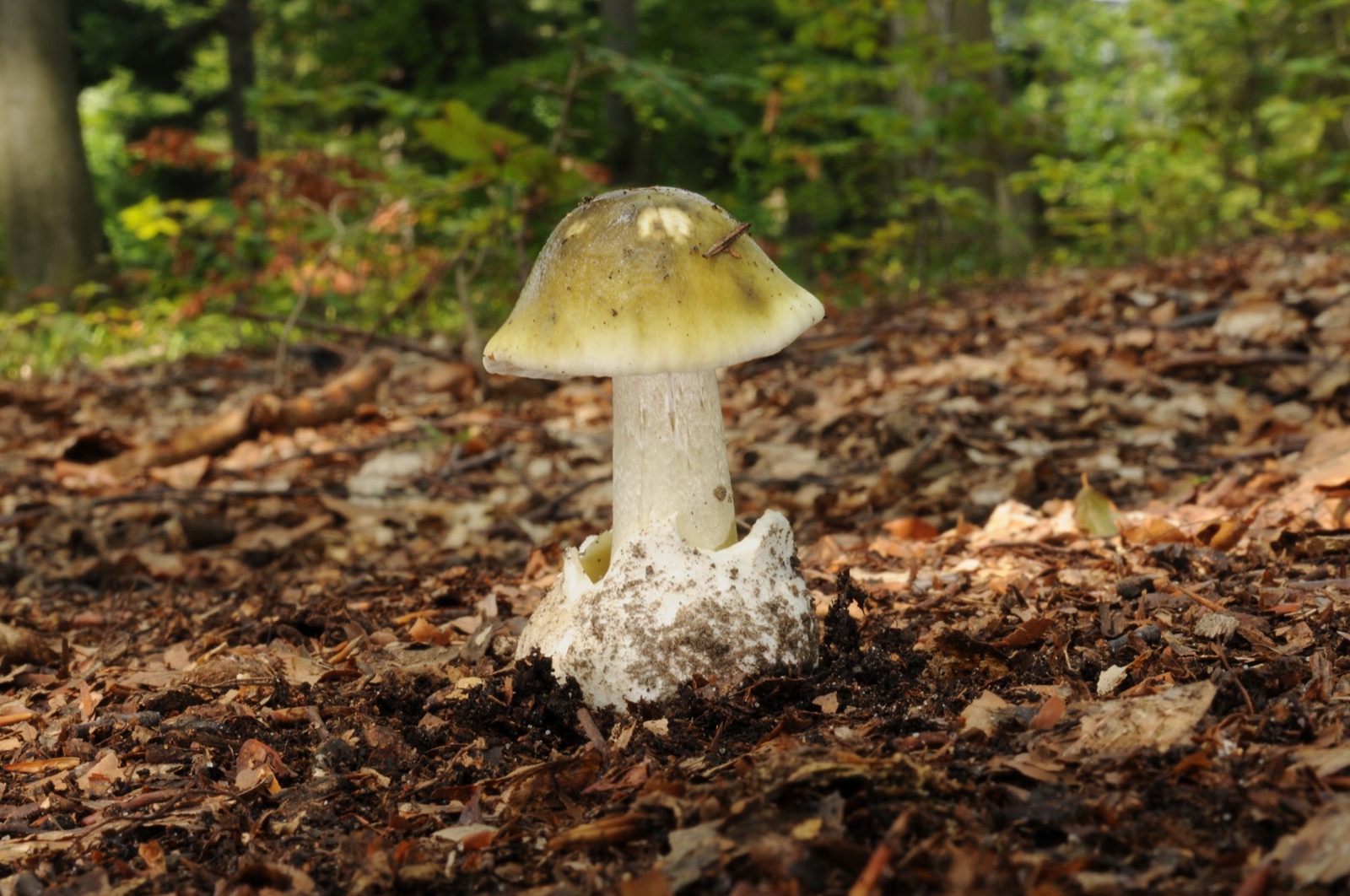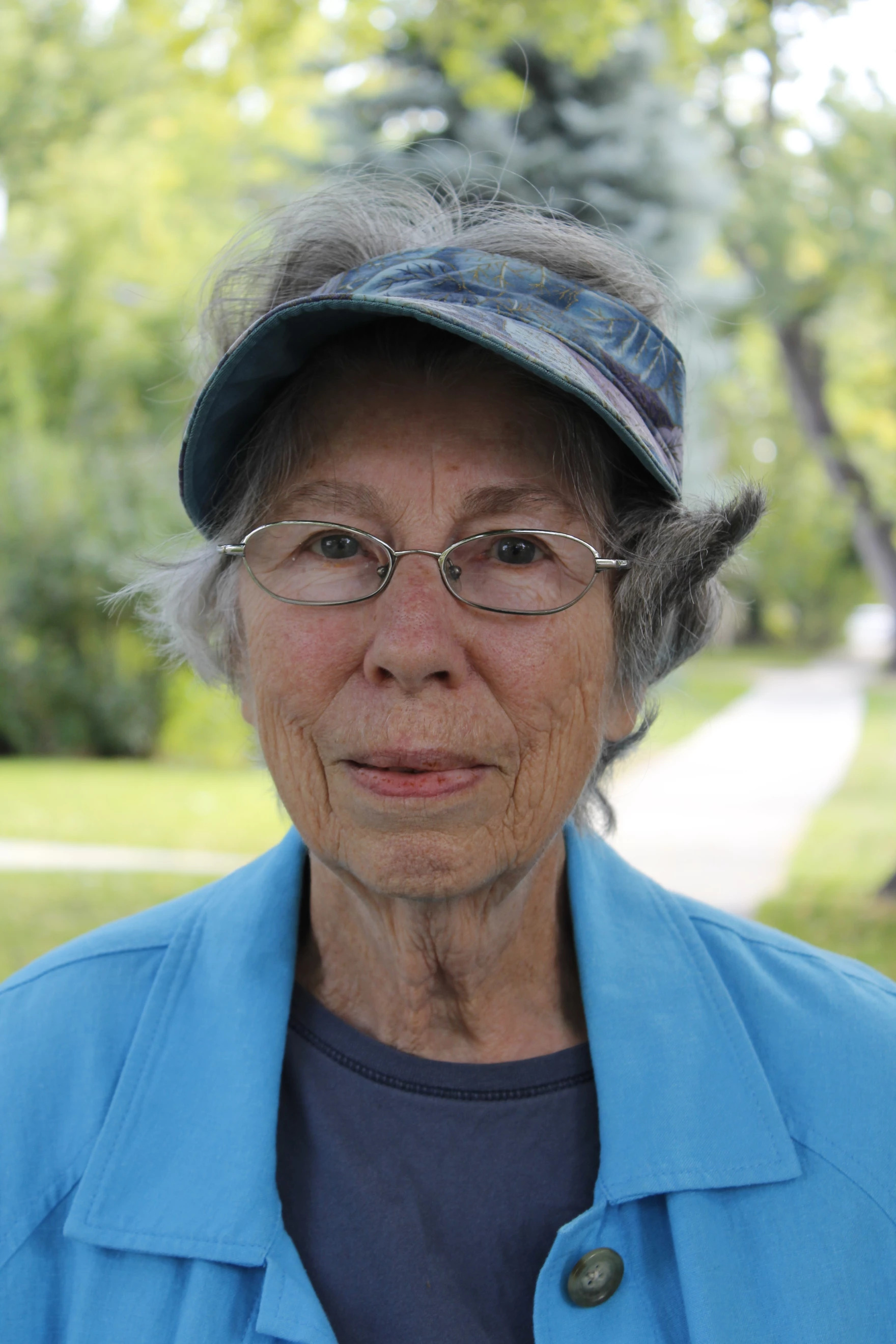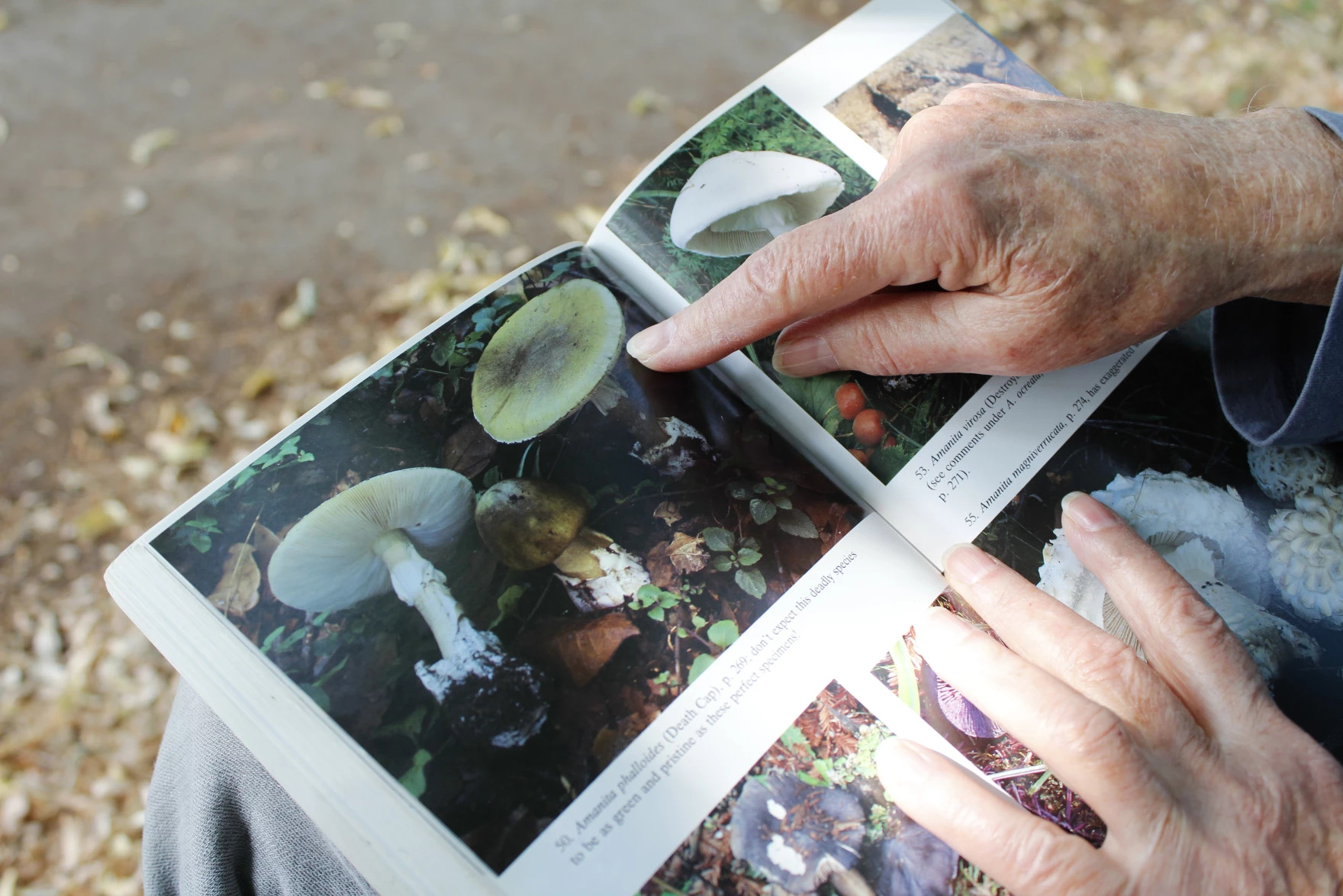Toxic Death Cap Mushrooms Take Root In The Mountain West
5:14 minutes

This article is part of The State of Science, a series featuring science stories from public radio stations across the United States. This story, by Madelyn Beck, was originally published by Boise State Public Radio News and Mountain West News Bureau.
Update: Another likely death cap mushroom has been found in the same Boise neighborhood as last year. Susan Stacy, the same woman who first discovered the fungus in the Mountain West, has found it along the busy residential street Harrison Blvd. It has not been DNA-confirmed yet.
Toxic mushrooms are not unusual in the Mountain West.

“This is probably a lepiota,” said Susan Stacy, looking at a mushroom on a recent afternoon in a Boise, Idaho, neighborhood not far from downtown. “See that little dark nub in the middle and little flecks around here?”
Stacy turned to her mushroom identification book.
“Edibility: to be avoided. Perhaps poisonous,” she said.
While this little mushroom could be problematic for a curious dog or child, it doesn’t compare to one of the world’s deadliest mushrooms – which Stacy discovered in Boise last September.
She remembers that it was a hot day, and she decided to take a detour from her normal route to check out a busier area where many lawns were “generously” watered.
“And here I come upon this mushroom, and I knew it was an Amanita because I had seen them before. And an Amanita, to my mind, is a gorgeous, statuesque, elegant creation. They’re just stately,” she said.
The genus Amanita includes, incidentally, the species on which the red and white mushroom emoji is likely based, which also happens to be poisonous.
So Stacy dug the mushroom up, careful to collect a little tissue sack that was around the base.
“I got out my Mushrooms Demystified book by David Arora,” she said, “and my mushroom fit his description of Amanita phalloides. So I said to myself, ‘Oh, cool! I found this species of Amanita.’”

What she didn’t initially realize was how serious that was. Amanita phalloides, known as the death cap, is often cited as killing more people than any other mushroom on earth. And before last fall, it hadn’t been identified in the Mountain West.
Just to be sure it was a death cap, a former pathologist named Mickey Myhre later helped confirm it using DNA analysis, which is a growing sector in mycology.
“When I started trying to learn about identifying mushrooms, I thought, ‘This is impossible, all these keys and codes. There’s got to be a better way,’” he said. “And then I started reading about DNA barcoding and I thought, ‘Ah, there’s a shortcut!’”
Myhre said mushroom DNA is an area where there’s still plenty to learn, but when it came to testing the suspected death cap, “We got between 99.85% and 100% match on the DNA sequence. And so by anybody’s criteria, it would be a good solid match.”
DNA confirmation is important because a lot of mushrooms are easily misidentified or even completely unnoticed.
Many mushroom species are still unknown, and one entire category is listed as “little brown mushrooms,” or LBMs.
It’s also still unknown what invasive mushroom species, like the death cap, might mean for trees and ecosystems.
That’s according to Anne Pringle, a University of Wisconsin professor who studies the spread of the death cap. She confirmed that it isn’t native to the U.S.
“I collected a lot of population genetics data and established that it was an introduction from Europe,” she said. “It’s particularly interesting because in California it’s shifted hosts.”
That is, since the death cap was first identified there in the 1930s or 1940s, it has started making friends with the native tree species. Pringle said that could be something to watch for in places like Boise, too.
The death cap has a symbiotic relationship with certain tree roots – like hornbeams and oaks – which means they give and take nutrients.
“It’s a mycorrhizal fungus, so it’s one of those fungi that people hear about that associate with trees and provide benefits to trees in exchange for carbon compounds,” Pringle said.
But the death cap’s underground root-like mycelium only produces mushrooms when its host tree matures. So it’s probably been underground in Boise for decades already, ever since trees were imported from California.
Krista Willmorth is president of the Southern Idaho Mycological Association. She says one association member had even warned that it might show up.
“Bob Chehey had always been telling us ‘we don’t have it, but we don’t have it yet,’” she said. “We have the conditions for it. Certainly seems like it could appear. And indeed it did.”
She said that cities like Vancouver, British Columbia, have found that once it’s there, it’s impossible to eradicate, even with fungicide.
“Fungicides are not going to help. They’re just going to add more poison to your environment,” she said.
Because of that, it’s important for people to identify death caps, and not eat them – dogs included. It doesn’t help that they reportedly taste delicious.
The mushroom is generally a few inches tall. The cap’s color is a light yellowish with a green tint and a sort of metallic sheen. But, it can get a little darker and duller with age.
Underneath is white gills and often a little white skirt around the stocky stem. And then there’s a little white tissue sack holding the base of the stem.
“As it grows up and pops up, it breaks that sack. And on these, that little sack remains around the bottom,” Willmorth said.
For those who still aren’t sure, they can also check the spore color. Just pop off the cap, place it gills-down on a piece of paper or foil, and cover with a bowl for a few hours. Spore prints are like fingerprints for mushrooms, and the spore color of death caps is white.
Of course, if you suspect someone has eaten a death cap, immediately call poison control.
In 2016, 14 Californians grew sick in a two-week period after eating death caps. Three needed liver transplants, and one young girl suffered permanent neurological damage.
Luckily, you can touch, pluck and throw away any mushroom without consequence, as long as you don’t eat it. Picking a mushroom doesn’t hurt the underground organism.
You can also reach out to a local mycological association or post to iNaturalist for help identifying the fungus so local residents can be warned.
But all of this requires residents to keep an eye out. That includes Susan Stacy in Boise, who is now working with the city parks department and others to monitor old oaks around neighborhoods.
“When you say that you’re an amateur mycologist, there’s a certain pride in that,” she said. “I think we have a great opportunity here to contribute something new to science.”
There’s agreement among mushroom aficionados that there aren’t enough certified experts to go around, and community scientists like Stacy have to step in to help identify mushrooms around the world.
Stacy had been looking at mushrooms in Boise since the ’80s, when she found the particularly odd – and somewhat adorable – Bird’s Nest Fungus. She may call herself an amateur with pride, but she has been interested in fungi longer than many mycology Ph.D.s in the field.
While there isn’t one official international mapping system for fungi, many post them on iNaturalist or Mushroom Observer.
So far, the only verified death caps in the Mountain West have been found in Boise in a few separate patches, but at least one other potential death cap was flagged on iNaturalist just east of Salt Lake City.
Health officials and researchers in New Mexico have reported a rash of other toxic mushroom blooms and poisonings, thanks to the monsoon season.
So as always, do not eat any mushrooms you can’t 100% identify. If there is any doubt, and you still want to eat it, ask someone who knows better.
“You will not appear dumb or or stupid, or anything like that, if you ask somebody who knows,” Stacy said. “Because your life is worth not getting sick over.”
This story was produced by the Mountain West News Bureau, a collaboration between Wyoming Public Media, Boise State Public Radio in Idaho, KUNR in Nevada, the O’Connor Center for the Rocky Mountain West in Montana, KUNC in Colorado, KUNM in New Mexico, with support from affiliate stations across the region. Funding for the Mountain West News Bureau is provided in part by the Corporation for Public Broadcasting.
Invest in quality science journalism by making a donation to Science Friday.
Madelyn Beck is a reporter with the Mountain West News Bureau based in Boise, Idaho.
KATHERINE WU: And now it’s time to check in on the state of science.
SPEAKER 2: This is KER–
SPEAKER 3: For WWO–
SPEAKER 4: Saint Louis Public Radio.
SPEAKER 5: Iowa Public Radio News.
KATHERINE WU: Local science stories of national significance. The next few days are the peak of spooky season, and we couldn’t ask for a better palate cleanser than the death cap. It’s an invasive mushroom that’s been spreading across the world and has recently been found in the Mountain West. With me here to discuss the death cap is Madelyn Beck, a reporter with the Mountain West News Bureau. She’s based in Boise. Madelyn, welcome to Science Friday.
MADELYN BECK: Great to be here.
KATHERINE WU: To start us off, what exactly is a death cap mushroom? That sounds very scary.
MADELYN BECK: Yeah, it definitely does, but when you look at it, it doesn’t look scary. Some of the mycological folks and people that are really into fungus will be like, oh, that looks like a very stately mushroom, or they have these lovely descriptions. But really, for the layman, it looks like a mushroom.
It’s got– it’s a couple inches tall. It’s got a little cap. It’s got gills. The cap is little greenish yellowish with a little bit of a metallic sheen to it. It’s got a thick stock.
It looks like your standard issue mushroom. But for those in the know, obviously, this is the potentially deadliest mushroom for humans in the world. It’s largely credited with killing more people than any other mushroom.
KATHERINE WU: Gotcha, and so where are these death caps usually found, and is that starting to change?
MADELYN BECK: They’d been found a little bit on the East Coast, but they really make the rounds on the West Coast. So they’d been initially identified there in the ’30s or ’40s in California, and now, we just this last year found the first death cap in the Mountain West. And so that was here in Boise, Idaho, and now this year the mushrooms are back again.
KATHERINE WU: That doesn’t sound so great, and it sounds like, just by appearances alone, it’s pretty hard to tell whether you’re looking at a death cap or something pretty harmless.
MADELYN BECK: Yeah, so it was originally identified by a woman named Susan Stacy here in Boise. She was part of a group called the Southern Idaho Mycological Association. She found it just on a walk, and she realized what it was, brought it back to her group, and said like, oh, this is cool. I found it in my book. It’s an amanita phalloides, or a death cap.
And people there were saying like, no, it’s not. That’s a– that’s not real. And they went over and looked at it, and they’re like, oh, Susan, you found a death cap. But like, what is going on here? But as far as how they were for sure certain, an actual former pathologist as part of the group, his name was Mickey Myhre, and he helped confirm it using DNA analysis.
MICKEY MYHRE: We got between 99.85% and 100% match on the DNA sequence, and so by anybody’s criteria, it would be a good, solid match.
KATHERINE WU: All right, well, you have me convinced, and what is the leading idea on how these mushrooms managed to migrate into the region?
MADELYN BECK: These kinds of mushrooms tend to have a symbiotic relationship with specific kinds of tree roots, and so in Boise, as in other places like Salt Lake and Denver, they imported trees from California decades ago as little saplings. But this specific kind of mushroom doesn’t fruit, does not produce actual mushrooms above ground, until trees are fully mature. So for these kinds of trees, it can take 30, 40, 50 years for that to happen, for them to actually reach maturity.
So now, all of a sudden, under these big old oak trees that were imported from California decades ago, that’s where they’re finding these mushrooms here now. The question is, will they spread to other native tree species? We really don’t know how they’re going to behave in this area.
KATHERINE WU: So what I’m hearing is that this is our parents’ and our grandparents’ fault.
MADELYN BECK: Exactly. Always blame them. Always.
KATHERINE WU: No, but in all seriousness, what are people supposed to do now that these mushrooms are starting to pop up in the area? How do people avoid them? Can anything be done to get rid of them?
MADELYN BECK: Yeah so, I want to be very clear just to start with that when it comes to– this has popped up all around like Vancouver, British Columbia, and there, they tried pretty much everything to get rid of it, including like fungicide. And really nothing they’ve done is helped, and that just adds more poisons to their environment and kills healthy, nice fungus.
So what we’ve really been talking with all the people in mycological associations have said is you need to just know that it’s here and know how to identify it. And with death caps, you can touch them. That’s not going to hurt you.
The concern is, obviously, ingestion for people or even pets like dogs. So yeah, you can just pluck the mushrooms, throw it away, not a problem. But if it is an actual death cap and it comes back year after year, you’re probably going to have to do that year after year.
KATHERINE WU: Madelyn Beck is a reporter with the Mountain West News Bureau. She’s based in Boise. Thank you for being with me today.
MADELYN BECK: Great to be here.
Copyright © 2022 Science Friday Initiative. All rights reserved. Science Friday transcripts are produced on a tight deadline by 3Play Media. Fidelity to the original aired/published audio or video file might vary, and text might be updated or amended in the future. For the authoritative record of Science Friday’s programming, please visit the original aired/published recording. For terms of use and more information, visit our policies pages at http://www.sciencefriday.com/about/policies/.
Kathleen Davis is a producer and fill-in host at Science Friday, which means she spends her weeks researching, writing, editing, and sometimes talking into a microphone. She’s always eager to talk about freshwater lakes and Coney Island diners.
As Science Friday’s director and senior producer, Charles Bergquist channels the chaos of a live production studio into something sounding like a radio program. Favorite topics include planetary sciences, chemistry, materials, and shiny things with blinking lights.
Katherine Wu is a staff writer at The Atlantic based in Boston, Massachusetts.